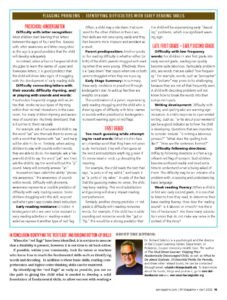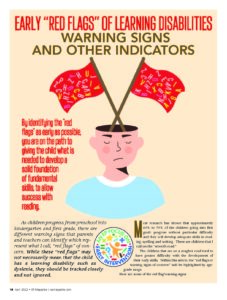By identifying the “red flags” as early as possible, you are on the path to giving the child what is needed to develop a solid foundation of fundamental skills, to allow success with reading.
This article originally appeared digitally in April, 2022 here. It is reposted by Cooper University Health Care with permission by EP Magazine. Subscribe for free at www.epmagazine.com.
As children progress from preschool into kindergarten and first grade, there are different warning signs that parents and teachers can identify which represent what I call, “red flags” of concern. While these “red flags” may not necessarily mean that the child has a learning disability such as dyslexia, they should be tracked closely and not ignored.
Most research has shown that approximately 60% to 70% of the children going into first grade progress without particular difficulty and they will develop adequate skills in reading, spelling and writing. These are children that I call on the “smooth road.”
The children that are on a rougher road tend to have greater difficulty with the development of their early skills. Within this article, the “red flags or warning signs of concern” will be highlighted by age-grade range.
Here are some of the red flag/warning signs:
Preschool-Kindergarten
Difficulty with letter recognition: Most children start learning their letters between the ages of four and five. Success with letter awareness and letter recognition at this age is a good predictor that the child will develop adequately.
In contrast, when a four or five-year-old child struggles to learn the names of upper and lowercase letters, it is good predictor that the child will show later signs of struggling with the development of early reading skills.
Difficulty connecting letters with their sounds; difficulty rhyming, and/ or playing with sounds and words: Preschoolers frequently engage with activities that involve various types of rhyming within their normal interactions in the classroom. For many children rhyming and awareness of sound are intuitively developed, that is it comes to them naturally.
For example, ask a four-year-old child to say the word “cat” and then ask them to come up with a word that rhymes with “cat,” and many will be able to do so. Similarly, when asking children to play with sounds within words, they are able to do so. For example, ask a five-year-old child to say the word “pat” and then ask the child to say the word without the “p” sound. Many will correctly answer “at.”
Researchers have called this ability “phonemic awareness,” the awareness of sounds within words. Difficulty with phonemic awareness represents a possible predictor of difficulty with early reading success. Some children struggling with this skill, respond well when given appropriate direct instruction.
Early reading resistance: Children in kindergarten who are seen to be resistant to early reading activities or reading-related activities represent another type of red flag.
Often, a child may understand that compared to the other children in their class, their skills are not developing easily and they then become more insecure and avoidant as a result.
Parent predisposition: Another predictor for reading difficulty is whether either (or both) of the child’s parents struggled with reading when they were young. Effectively, there is a “pass down” that occurs when one or both parents struggled when they were young.
Early Stage Summary: In summary, these early predictors in preschool through kindergarten start to add up like they are weights on a scale.
The combination of a parent experiencing early reading struggling and the child who is showing signs of difficulty with letter names or sounds within preschool or kindergarten, represent warning signs or red flags.
First Grade
Too much guessing while attempting to read words: When children face an unfamiliar word that they have not previously memorized, they will often guess at the word and substitute anything, even if it’s nonsensical or ends up disrupting the meaning.
For example, the child reads the text that says, “a picture of my rabbit,” and reads it as “a porto of my raber.” In spite of the fact that the guessing makes no sense, the child may keep reading. This word substitution and guessing will clearly impact reading comprehension.
Similarly, another strong predictor in first grade is difficulty with reading nonsense words. For example, if the child has trouble sounding out nonsense words like “gat or “fip,” this would be a strong predictor that the child will be experiencing early “decoding” problems, which is a significant warning sign.
Late First Grade-Early Second Grade
Difficulty with low frequency words: For children in later first grade into early second grade, reading can quickly become quite laborious. Particularly problematic, are words that are called “low frequency.” For example, words, such as “porcupine” and “volcano” may prove to be challenging because they are not all that frequently seen. A child with decoding problems will not know how to break the words into their component parts
Writing development: Difficulty with writing and spelling also are warning sign indicators. A child’s response to open-ended writing, such as, “write about your weekend” can be a good indicator as to how the child is developing. Questions that are important to consider include: “Is writing a laborious process?” “What does the spelling look like?” “How are the sentences formed?”
Difficulty following directions: Difficulty following directions is often a significant red flag of concern. Such children become confused readily and need extra time to understand what is being asked of them. The difficulty may be an indicator of a problem with processing and understanding basic language.
Weak reading fluency: When a child is in first and early second grade, it is essential to listen to how they read, to determine their basic reading fluency. How does the reading sound? Is it labored or smooth? Are there lots of hesitancies? Are there many substitution errors that do not make any sense in the context of the story?
In Conclusion: Identifying the “Red Flags” and Building Bottom-Up Skills
When the “red flags” have been identified, it is not time to assume that a disability is present, however, it is not time to sit back either.
If possible, within your community, look for tutors or teachers who know how to teach the fundamental skills such as identifying words and decoding. In addition to these basic skills, reading comprehension and higher-order thinking skills can be mastered.
By identifying the “red flags” as early as possible, you are on the path to giving the child what is needed to develop a solid foundation of fundamental skills, to allow success with reading.
ABOUT THE AUTHOR:
Dr. Richard Selznick is a psychologist and the director of the Cooper Learning Center, Department of Pediatrics, Cooper University Health Care. The author of “The Shut-Down Learner: Helping Your Academically Discouraged Child”, as well as “What to Do about Dyslexia: 25 Essential Points for Parents,” and three other related books. He can be contacted through email: selznick-r@cooperhealth.edu. To learn more about his books, blogs and podcasts, go to www.shutdownlearner.com and www.cooperlearningcenter.org.



